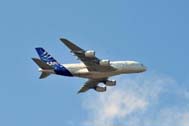NLR researches night glide flights in SESAR project

The National Aerospace Laboratory (NLR) will conduct joint research with KLM airlines and Air Traffic Control the Netherlands (LVNL) to determine if it is possible to expand the number of Continuous Descent Approaches, or glide flights, performed at night. NLR and partners will conduct this collaborative research as part of AIRE, the SESAR programmes green component (see box).
 Continuous Descent Approaches (CDAs), or glide flights, reduce levels of harmful emissions and generate less noise. CDAs, which are currently flown between 11:00pm and 06:00am at Schiphol airport, are flights that continuously descend from an altitude of 4000 feet (approximately 1.2 kilometres). When the traffic situation permits, continuous descent flights are flown from cruising altitude (approx 11 kilometres or Top of Descent)
Continuous Descent Approaches (CDAs), or glide flights, reduce levels of harmful emissions and generate less noise. CDAs, which are currently flown between 11:00pm and 06:00am at Schiphol airport, are flights that continuously descend from an altitude of 4000 feet (approximately 1.2 kilometres). When the traffic situation permits, continuous descent flights are flown from cruising altitude (approx 11 kilometres or Top of Descent)Experience has shown that these fuel-saving, emission-reducing procedures are disturbed regularly because of heavier traffic after 04:00am. KLM, LVNL and NLR will conduct research to determine how these Top of Descent CDAs can be flown throughout the entire night
For aircraft performing CDAs, there is a certain degree of uncertainty regarding their flight paths. The aircraft itself determines its optimum flight path, and consequently more space is required between aircraft than during normal approaches. Because of this uncertainty, the air traffic controller sometimes needs to intervene. This leads to an aborted CDA and an increase in fuel usage. A better planning of the flights could lead to less intervention and more frequent use of CDAs.
As part of AIRE, the LVNL, KLM and NLR are working to develop a system innovation that will allow aircraft to land according to tighter schedules, which will allow CDAs to be more frequently flown also during night-time peak hours. This is possible if an aircraft is controlled in an earlier stage of the flight (far before the Dutch border). To realize an optimal planning, the planning system will be able to communicate to the KLM aircraft through satellite via KLMs Operations Control Centre. An optimal schedule will be devised based on this data allowing aircraft a high probability to fly an undisturbed CDA.
NLRs responsibilities within this consortium include developing the system that collects data en facilitates communication between the stakeholders. The system will then process the data into an optimal schedule required to allow flights to be operated as efficiently as possible. The project recently kicked-off and will run for 15 months. The project also involves a comprehensive series of tests, lasting 1 to 2 months, during which the system will prove its capabilities during actual flight operations.
As part of AIRE, the LVNL, KLM and NLR are working to develop a system innovation that will allow aircraft to land according to tighter schedules, which will allow CDAs to be more frequently flown also during night-time peak hours. This is possible if an aircraft is controlled in an earlier stage of the flight (far before the Dutch border). To realize an optimal planning, the planning system will be able to communicate to the KLM aircraft through satellite via KLMs Operations Control Centre. An optimal schedule will be devised based on this data allowing aircraft a high probability to fly an undisturbed CDA.
NLRs responsibilities within this consortium include developing the system that collects data en facilitates communication between the stakeholders. The system will then process the data into an optimal schedule required to allow flights to be operated as efficiently as possible. The project recently kicked-off and will run for 15 months. The project also involves a comprehensive series of tests, lasting 1 to 2 months, during which the system will prove its capabilities during actual flight operations.
AIRE, which stands for Atlantic Interoperability Initiative to Reduce Emissions, is an agreement between the European Commission and the Federal Aviation Administration (FAA). AIRE invites researchers to produce research projects that through partnership and use of existing technologies benefit the environment.
AIRE is part of the European project SESAR (Single European Sky ATM Research), which, among its many objectives, aims to improve the ATM (Air Traffic Management) system and thus help reduce CO2 emissions in Europe by 10 percent. AIRE strives to facilitate the incorporation of green experiments into daily green ATM operations. AIRE therefore is an integral part of the SESAR programmes green component. In addition, AIRE fosters partnerships within the aviation sector.
KLM, LVNL and NLR have in a consortium led by LVNL submitted a proposal to the SESAR Joint Undertaking (SJU). SJU is responsible for managing the SESAR programme.
AIRE is part of the European project SESAR (Single European Sky ATM Research), which, among its many objectives, aims to improve the ATM (Air Traffic Management) system and thus help reduce CO2 emissions in Europe by 10 percent. AIRE strives to facilitate the incorporation of green experiments into daily green ATM operations. AIRE therefore is an integral part of the SESAR programmes green component. In addition, AIRE fosters partnerships within the aviation sector.
KLM, LVNL and NLR have in a consortium led by LVNL submitted a proposal to the SESAR Joint Undertaking (SJU). SJU is responsible for managing the SESAR programme.

.jpg)


.png)



Comments
There are no comments yet for this item
Join the discussion